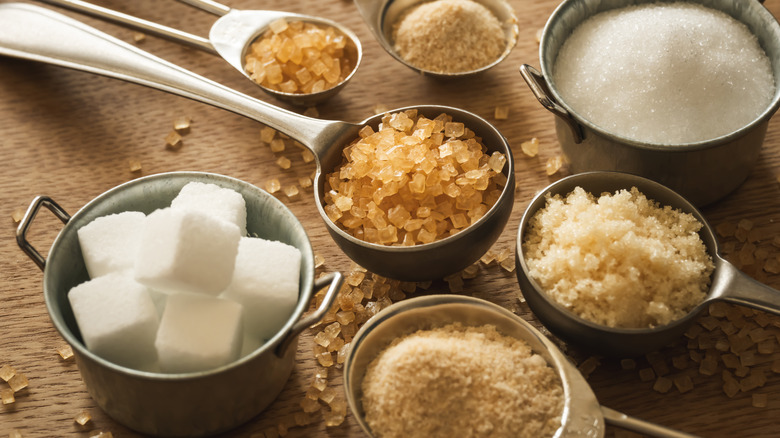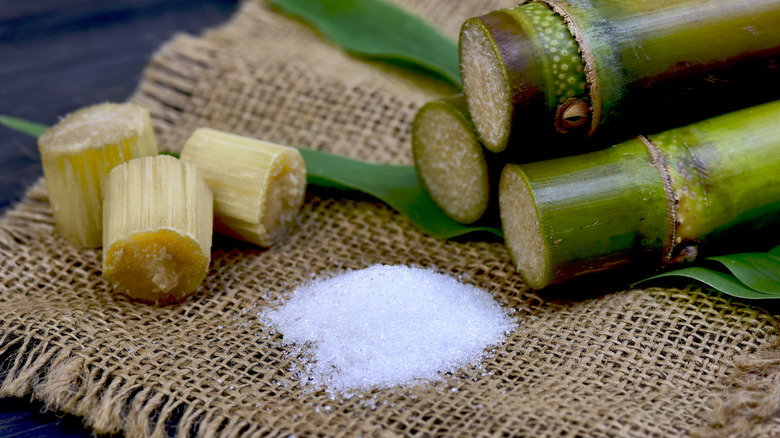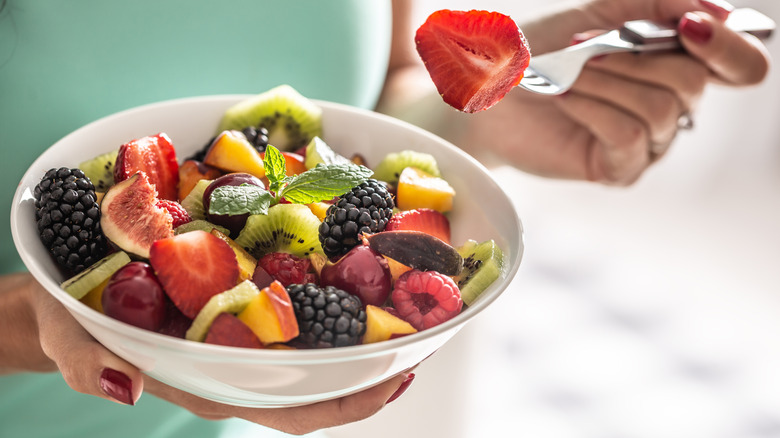Processed Sugar Vs Natural Sugar: What's The Difference?
Sugar is an integral ingredient in the kitchen, from sweetening up chocolate chip cookies to enhancing the flavors of meat. But with all the different kinds of sugar available — white, brown, coconut, turbinado, and maple just to name a few — it's sometimes hard to tell them apart, let alone decide what to grab off the shelf when preparing different recipes.
Beyond the baking aisle, sugar comes in more forms than many of us realize. It's not just a white powder you stir into your coffee — it's found in fruits, carbs, and even dairy. Some sugars are granulated and processed, while others remain in their natural state. Although they may serve the same purpose — adding sweetness and flavor — the type of sugar you use can affect your dish's taste, texture, and overall vibe. This is especially true of processed versus natural sugars. Bakers, chefs, and home cooks alike often make ingredient choices based on how the sugar behaves in heat and moisture, and how its flavor and texture blends with the other flavors of the dish. Whether you're a curious home baker or just wondering why some recipes call for dates and others for cane sugar, it helps to understand what the true difference is between processed sugars and natural sugars, and how each kind will affect your dish.
Processed sugar is considered 'added sugar'
Processed, or "refined," sugar refers to the type that's been extracted and isolated from a natural source — most commonly sugarcane, sugar beets, or corn — and then purified into a form you'd recognize in your kitchen. Whether it's white sugar, brown sugar, corn syrup, or high-fructose corn syrup, these sugars begin as plant material and end up in your baked goods, beverages, or condiments.
While all green plants produce sugars through photosynthesis, only a few contain high enough concentrations to make commercial sugar extraction worthwhile. Sugarcane and sugar beets are the big players when it comes to granulated sugar, while corn is the main source of corn syrup. Even "raw" sugar and regular honey are considered processed, though they undergo less refining.
The processing steps vary slightly by source, but generally follow the same pattern: crushing, extracting juice or starch, filtering, and crystallizing or converting into syrup. For example, sugarcane juice is boiled and crystallized into raw sugar, which is then purified and re-crystallized into the white sugar we know. Corn syrup, meanwhile, is made by converting corn starch into glucose using enzymes, then refining and filtering it for clarity and sweetness.
In short, processed sugar is simply sugar stripped from its original plant source, repackaged in a more potent and shelf-stable form. It's commonly added to not just desserts and sweet sodas, but also items like salad dressings, condiments, yogurts, and cereals — and will show up as "added sugar" on nutrition labels.
Natural sugar is found in fruits, veggies, and even milk
Natural sugar, as the name implies, is sugar content that is still in its original, natural source. You'll find it in all fruits, many vegetables such as carrots, butternut squash, and peas, as well as dairy products like whole milk (where it's known as lactose). Unlike processed sugar, natural sugar is usually combined in food with fiber, water, vitamins, and minerals, all of which impact how your body digests it.
In fruits and veggies, the types of sugar present is primarily fructose and glucose. These types are absorbed more gradually thanks to the fiber content, which slows digestion and provides more sustained energy. On the other hand, processed sugar spikes blood sugar levels and insulin, leading to the inevitable "sugar crash."
Even in dairy, lactose comes naturally paired with fats and proteins that influence how it is metabolized. That said, once dairy is flavored — think chocolate milk, vanilla yogurt, or ice cream — it often contains a combination of natural and added sugar, so it's worth checking the label if you're curious.



